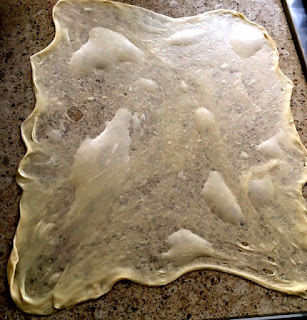 |
| Mom's Pinakbet.. and I helped her make this! |
Usually I consult with my mom on any new recipe, Filipino or not, getting her advice on what ingredients to use and method of cooking. She is a self-taught home cook and one of the best in my books! She rarely uses recipes but seems to have a knack for honing in on what makes a dish taste authentically delicious. Her culinary wisdom has guided me and helped me nail many of the dishes on my first try like lumpiang shanghai (spring rolls), pancit canton (noodle stir fry), bibingka (coconut cake) and leche flan (caramel custard).
However, I was under a personal time crunch wanting to post my pinakbet recipe on my blog last weekend. So I resorted to researching numerous recipes online and in cookbooks. I landed on a pinakbet recipe from the cookbook, Filipino Homestyle Dishes, Delicious Meals in Minutes by Norma Olizon-Chikiamco. The pinakbet recipe was titled, "Braised Pork with Vegetables (Pinakbet)".
Did you know: Pinakbet is a dish that originated from in the Iloco region (Northwestern Luzon in the Philippines) and now popular throughout the Philippines.The pinakbet photo in the cookbook made me salivate featuring the bright colours of the vegetables, gulay (GOO-lie). Layered greens from the okra, green beans and the bitter gourd, ampalaya (am-pah-lie-YA), and pop of golden yellow from the pumpkin and sauteed pork belly. There were thoughtful instructions on how to prep the bitter gourd (seed, slice and soak in a salt and vinegar brine), which is a new vegetable for me to cook with and the rest of the recipe seemed fairly straight forward.
 |
| Layered pinakbet vegetables which I over cooked;( |
 |
| My failed Pink Pinakbet (not suppose to be pink), but a good learning experience! |
This is her prognosis on my key recipe mistakes:1) Used raw bagoong, the shrimp fry is still pink. I should have use sauteed bagoong that you either fry yourself with oil, onion and garlic or you can buy already fried bagoong, which looks like a thick and dark brown oily paste.
 |
| Uncooked bagoong |
 |
| Sauteed bagoong - use this one! |
 |
| Indian bitter gourd (on the left) and Chinese bitter gourd (on the right) |
Here's my Mom's pinakbet recipe, a tasty sure bet!
 |
| Pinakbet Gulay (vegetables) |
 |
| Pinakbet gulay (vegetables) about to be cooked! |
1 1/2 cups bitter gourd (Indian variety), seeded and sliced into small pieces
2 tbsp salt
1/4 cup thinly sliced uncured pork belly (can use bacon instead)
1 cup raw shrimp (preferably fresh with shell)
1 medium onion, chopped
3 cloves of garlic, minced
1/8 cup fresh ginger, peeled and thinly sliced
1 cup roma tomato, diced
3 tbsp sauteed bagoong
2 cups long green beans, cut into 2" lengths1 1/2 cups okra, trimmed and sliced into 1" pieces
4 cups Chinese eggplant, cut into 1" chunks
4 cups pumpkin, peeled and cubed
2 cups water
Salt and fish sauce (patis) to taste
Directions
1. Sprinkle 2 tbsp salt on sliced bitter gourd and set aside for 15 minutes. Then rinse salt off bitter gourd with water.
2. Over medium heat, place sliced pork belly in a sauce pan and saute for 5 minutes or until crisp and golden brown. Remove pork and keep rendered fat in the pan to saute the shrimp for 3-5 minutes or until shrimp turn pink. Then immediately remove from pan to avoid from overcooking and getting tough.
3. In the same pan with the pork belly's rendered fat, saute the onion with a pinch of salt until it turns translucent, 3-5 minutes. The add the garlic, ginger, tomatoes and bagoong. Saute for 5-7 minutes until the tomatoes break down and become a sauce.
4. Add the vegetables, green beans, okra, pumpkin, eggplant and 2 cups of water. Mix all the vegetables together in the sauce. Once the sauce starts to boil then add the bitter gourd. The goal is to not stir the pinakbet while it is cooking as it could make the dish quite bitter. Cover the pan and let steam for 15-20 minutes or until the vegetables are just tender.
5. Season with fish sauce then top with the cooked shrimp and crispy pork belly. Serve with hot white fluffy rice and eat immediately, masarap!
 |
| Pinabket ready to be devoured! |

















































